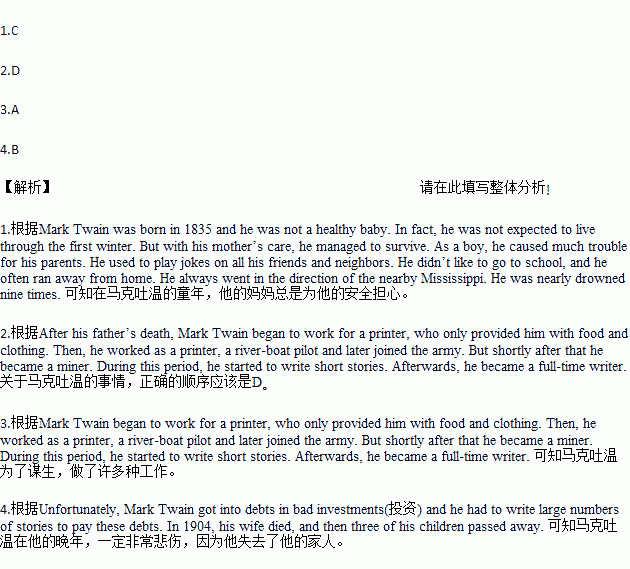题目内容
Mark Twain left school when he was twelve. He had little school education. In spite of this, he became the most famous writer of his time. He made millions of dollars by writing. His real name was Samuel Langhorne Clemens, but he is better known to all over the world as Mark Twain, his penname.
Mark Twain was born in 1835 and he was not a healthy baby. In fact, he was not expected to live through the first winter. But with his mother’s care, he managed to survive. As a boy, he caused much trouble for his parents. He used to play jokes on all his friends and neighbors. He didn’t like to go to school, and he often ran away from home. He always went in the direction of the nearby Mississippi. He was nearly drowned nine times.
After his father’s death, Mark Twain began to work for a printer, who only provided him with food and clothing. Then, he worked as a printer, a river-boat pilot and later joined the army. But shortly after that he became a miner. During this period, he started to write short stories. Afterwards, he became a full-time writer.
In 1870, Mark Twain got married. In the years that followed he wrote many books including The Adventures of Tom Sawyer in 1876, and The Adventures of Huckleberry Finn in 1884, which made him famous, and brought him great fortune.
Unfortunately, Mark Twain got into debts in bad investments(投资) and he had to write large numbers of stories to pay these debts. In 1904, his wife died, and then three of his children passed away.
At the age of 70, his hair was completely white. He bought many white suits and neckties. He wore nothing but white from head to foot until his death on April 21, 1910.
1.In Mark Twain’s childhood, ____________.
A. he learned a lot at school
B. he often went swimming with other boys
C. his mother often worried about his safety
D. he often played games with other boys
2.Which of the following shows the right order about Mark Twain?
a. He became a miner.
b. He worked as a printer.
c. He got into debts.
d. His father died.
e. He became a full-time writer.
f. He joined the army.
A. a-d-b-c-e-f B. c-b-d-f-e-a
C. d-a-f-e-b-c D. d-b-f-a-e-c
3.In order to make a living, Mark Twain ____________.
A. did many kinds of work
B. first worked as a printer
C. wrote stories in the beginning
D. joined the army after he worked in a mine
4.In the later years of his life, Mark Twain ____________.
A. wrote many stories and earned a lot of money
B. must have been very sad because he lost his family
C. continued writing until his death
D. lent too much money to others

